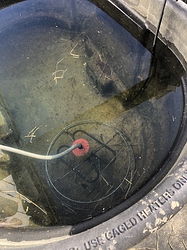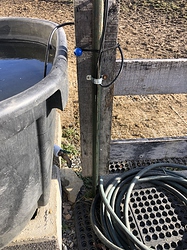I’ve been using a drain plug heater for several years. It’s worked well, but the PITA factor is very high. Install it every fall, and de-install it in spring. The attachment contraption plastic screw-in thing was awful to work with. Plus, if I needed to empty the tank with the heater installed, I had to pull the whole thing out and fully dump it. Also this summer I finally got smart and installed a faucet in place of the plug, and with a hose, a hose quick-connect, and gravity, draining and cleaning is a snap. I didn’t want to dismantle that system.
So on impulse, I bought a sinking/caged tank heater when I saw one at my local feed store several weeks ago. Installation was as easy as dropping it in the tank, plugging it in, and turning it on… after years of the DP heater, I appreciated that! I’ve used it several times, and knock on wood, it’s done its job well. The instructions say to plug directly into a GFCI outlet, but the cord is too short for my setup. I use an extension cord, specifically a 10-gauge 25’ 3-prong heavy-duty outdoor extension cord, and plug that into the outlet. The cord has a light at the end so I can see if I remembered to turn it on. So far, I’ve only had it on at night when temps go below 28-30. With the frigid temps coming up, it may be on through the day for a few days.
I learned about the possibility of electric shock here on COTH (thanks COTH, ignorance was bliss!). After installing the new heater, I tested the water with a multimeter. I got a very small reading, can’t remember how much, but it was very low. The internet said it probably wasn’t enough to be a problem for most livestock, but the internet also said that horses could be sensitive to the smallest bit of current in the water. So I took a length of electric fence grounding wire and was going to pound in a ground rod (ugh) when I realized I had a t-post right next to the tank… I re-tested the tank while grounding on the metal post, and success! The current was so negligible that the t-post was sufficient to ground it out completely. So I wrapped the wire around the post with a good connection at the end, put the other end in the tank, and the job was done.
I’m not sure the very small bit of current would have made a difference, but I’m secure knowing that my tank is grounded, and I enjoy watching my horses drink long and deep while the heater is turned on. I keep half the tank on the paddock side and half on the outside so I can drain, use heaters, etc. without actually going into the paddock.
The heater had something that ensured the heating element stayed centered on the cage, but it seemed kinda flimsy. I decided on more insurance, so I weaved in a spiral fence splicer to better connect the parts and secured it with a pipe clamp.
I’ve read some very interesting threads on COTH about keeping tanks ice-free using compost, passive solar, etc. I’ve considered these methods, and those who have found success are very happy with them. I decided, though, that if I can avoid it I don’t want another project in my life that requires materials, mental effort, and time. I live on rural property, and I have more than enough of those already. If the power goes out for an extended time during a freeze, that will be another story…
Not sure why the photos aren’t showing. They’re pictures of what I did with my tank. I find visuals sometimes easier to understand than descriptions.
ETA: got the photos to work
1.HEIC (3.1 MB)
2.HEIC (1.8 MB) 3.HEIC (1.3 MB)h




 I love having my tanks outside the field, it’s just so much easier!
I love having my tanks outside the field, it’s just so much easier!